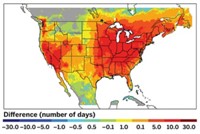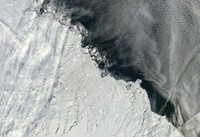Advertisement
Grab your lab coat. Let's get started
Welcome!
Welcome!
Create an account below to get 6 C&EN articles per month, receive newsletters and more - all free.
It seems this is your first time logging in online. Please enter the following information to continue.
As an ACS member you automatically get access to this site. All we need is few more details to create your reading experience.
Not you? Sign in with a different account.
Not you? Sign in with a different account.
ERROR 1
ERROR 1
ERROR 2
ERROR 2
ERROR 2
ERROR 2
ERROR 2
Password and Confirm password must match.
If you have an ACS member number, please enter it here so we can link this account to your membership. (optional)
ERROR 2
ACS values your privacy. By submitting your information, you are gaining access to C&EN and subscribing to our weekly newsletter. We use the information you provide to make your reading experience better, and we will never sell your data to third party members.
Environment
Higher Temperatures May Mobilize Lingering Pollutants
Persistent Pollutants: New model suggests that climate change could help redistribute persistent organic pollutants
by Valerie Brown
October 12, 2010
Although governments have banned many persistent organic pollutants (POPs), such as DDT and polychlorinated biphenyls (PCBs), the chemicals still linger in soil and water long after their release into the environment. Now a new study reports that rising global temperatures could mobilize these POP reservoirs and release the pollutants back into the atmosphere (Environ. Sci. Technol., DOI: 10.1021/es101771g).
POP emissions primarily come from factories that manufacture the chemicals or products that contain them. But, once emitted, POPs can travel great distances through the atmosphere before adsrbing into soil or water. The pollutants can remain in these terrestrial sinks for many years before degrading. The chemicals can also return to the atmosphere when warm temperatures promote their volatilization.
Recent research has shown that POP sinks have begun to slowly release their lingering loads as global temperatures rise. The United Nations Stockholm Convention, which administers the international agreement banning some 21 POPs, has called for studies to ascertain how climate change may trigger new human and animal exposures to POPs.
So Jianmin Ma and Zuohao Cao of Environment Canada's Air Quality Research Division constructed a model for simulating POPs’ behavior in a changing climate.
The researchers started with an existing model that simulates how POPs exchange between air and water and between air and soil. The model includes climate variables such as temperature and precipitation, but excludes the effects of wind. To simulate actual POP concentrations, the team used literature data on air, soil and water concentrations for three classes of POPs: hexachlorobenzene, hexachlorocyclohexanes (HCHs), and PCBs. The three classes serve as "indicators" for POPs in general, Ma says.
Finally, to model climate change, Ma and Cao allowed temperatures to fluctuate according to warming scenarios expected by the Intergovernmental Panel on Climate Change.
Under climate change conditions, POP levels spiked by varying degrees in the model. When the researchers increased temperatures by 0.05 K per year, concentrations of two HCH species jumped by 23% and 4%, respectively. Meanwhile, levels of a PCB species, PCB-153, rose by 58%. And the type of POP sink mattered: Levels of pollutants released from soil to air were an order of magnitude greater than from water to air.
The model's data shows that "there is a significant potential for POPs to pose a threat to humans, animals and the environment for many years from their re-emission from historically contaminated sources," Ma says.
Thomas McKone, senior scientist in the Environmental Technologies Division of Lawrence Berkeley National Laboratory, says the current study represents a good start on the problem, but it is still limited. POP levels are not uniform everywhere, because winds can transport the chemicals, which leads to variation across regions. So, he says, a more complete model should include the effects of wind on POP concentrations.





Join the conversation
Contact the reporter
Submit a Letter to the Editor for publication
Engage with us on Twitter